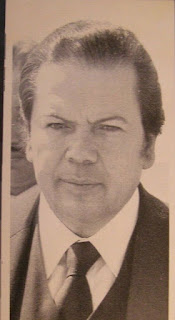“Sol Prendido” for Borderland Beat
The DEA discovered that the Mexican government, with which they necessarily had to coordinate, also protected the drug traffickers.
Manuel Bartlett, Secretary of the Interior from 1982 to 1988.
In 1985, during the DEA’s “frantic” investigation and search after the kidnapping of its special agent Enrique Kiki Camarena and his pilot Alfredo Zavala, US authorities realized that their Mexican colleagues, as well as officials and politicians, were actually protecting the Guadalajara Cartel and had even participated in meetings to plan the kidnapping, interrogation, torture and murder of its citizens, including the officer they sent to Mexico to investigate them.
US Marines move the body of Enrique Camarena.
According to the accusation against Caro Quintero, the US prosecutor assured Judge Edward Rafeedie that he was able to learn through the testimonies of informants and collaborating witnesses, that the operations of the Guadalajara Cartel were supported by officials such as:
Enrique Álvarez del Castillo, Governor of Jalisco.
Manuel Bartlett, Secretary of the Interior.
Manuel Ibarra Herrera, director of the Federal Judicial Police.
Miguel Aldana Ibarra, director of Interpol Mexico.
Juan Arévalo Gardoqui, Secretary of Defense.
Manuel Bartlett, Secretary of the Interior in the government of Miguel de la Madrid.
The DEA was convinced that the cartel and its leaders, Rafael Caro Quintero, Ernesto Fonseca, and Miguel Ángel Félix Gallardo, had ordered the crimes as revenge for a series of operations that affected their operations and to find out how far their agents had managed to infiltrate inside the organization, so the topic became highly relevant and the meetings to design the crime, which were several, had the presence of relevant figures from organized crime but also from Mexican politics.
“Those meetings were attended by traffickers and representatives of every agency of the Mexican government that had an interest in the cartel’s operations and its success (…) prominent politicians were also present at some meetings, including Enrique Álvarez del Castillo, Governor of Jalisco; Manuel Bartlett Díaz, the Secretary of the Interior; and Javier García Paniagua, the president of the Institutional Revolutionary Party.
“Key personnel from the judiciary attended, including Manuel Ibarra Herrera, the director of the Mexican Federal Judicial Police, and Miguel Aldana Ibarra, director of Interpol in Mexico.
“Finally, the Army was also represented through the presence of Juan Arévalo Gardoqui, Secretary of Defense,” assured the United States prosecutor’s office.
Miguel Aldana Ibarra
The actions, investigations, and undercover operations carried out by the DEA in Mexico had already caused a wound within the Guadalajara Cartel derived from seizures and the destruction of tons of marijuana in Zacatecas and Chihuahua, and now the capos were seeking revenge.
The US government realized, perhaps too late, that its agents were being tracked by the narcos they were after, and that their Mexican colleagues were leaking information to the cartel.
“Corruption between high-ranking Mexican government officials and law enforcement officials was deep. Law enforcement officers were on the traffickers’ payroll. They were also on the payroll of high-ranking politicians and military officials who, along with corrupt law enforcement officials, allowed traffickers to grow and distribute narcotics without significant interference from any legitimate law enforcement agency,” the prosecution continued.
Enrique Álvarez del Castillo, former Governor of Jalisco.
According to the DEA, along with the Mexican police, they had the opportunity to apprehend Rafael Caro Quintero before he fled to Costa Rica the same day that Camarena was murdered; however, they let him go.
According to testimonies of anti-drug agents, the first commander Armando Pavón Reyes, of the Federal Judicial Police of Mexico, allowed Caro Quintero to flee on a flight from the Guadalajara Airport on February 9, 1985, after a tense meeting between Mexican officers and bodyguards of the capo.
Shortly after, Pavón Reyes was appointed head of the Mexican investigation for the Camarena case, and according to the United States drug enforcement agency, he tried to convince them that Camarena and Zavala had been murdered by a family in Michoacán surnamed Bravo, and who had a ranch in the municipality of Zamora.
“Mexican authorities sought to blame the Bravo family for Camarena’s kidnapping and to that end, they searched Rancho Bravo on March 4, 1985, for the bodies of Camarena and Zavala. They found nothing.”
Miguel Aldana Ibarra, director of Interpol Mexico.
One day after the search, and without the Mexican government explaining more details about how it found the trail, Camarena’s bodies were found buried in front of the ranch, wrapped in plastic and barely recognizable due to the state of decomposition in which they were discovered.
Manuel Ibarra Herrera
All the evidence in the case first passed through the hands of Mexican authorities, whom the DEA began to mistrust and, finally, ended up pointing out as accessories to one of the most prolific drug trafficking organizations of the eighties: the Guadalajara Cartel.
Source: borderlandbeat.com













